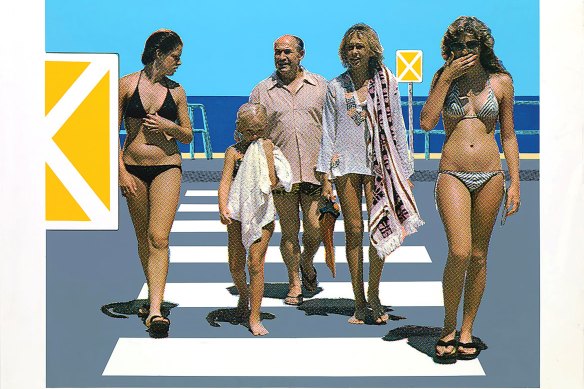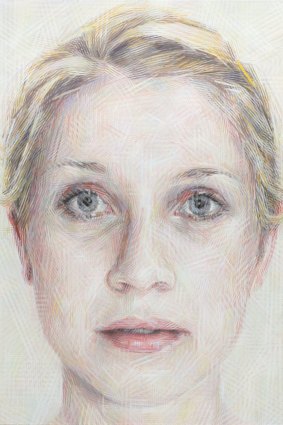Sally Robinson came from England at the age of eight, trading a childhood in Surrey for a life in the harsh Australian sunlight. She may not have had a language barrier to overcome, but the culture shock – or perhaps the weather shock – must have been profound. Eight is an impressionable age, a time when a child’s personality and preferences are finding forms that will stay with them for the rest of their life.
In the silk screen prints Robinson made in the 1970s and 80s one can still feel the impact of that childhood relocation. Although they depict relatively ordinary aspects of Australian life – birds and animals, the beach, the desert, suburban pastimes – these works are so bright and colourful that they feel unnatural, as if the artist has dialled up the intensity beyond the point where most of us feel comfortable.

Sally Robinson’s Beach Crossing.
It’s these dazzling, eye-catching prints that made Robinson’s reputation at a time when the medium was allowed a more prominent role in local contemporary art, largely because of the political poster movement. But while her peers were creating large-edition, militant statements about women’s liberation, Aboriginal land rights, anti-nuclear campaigns and workers’ solidarity, Robinson was cramming her pictures with images of leisure and local wildlife. The political posters still look great, but they have become time capsules, forever welded to the issues of the day. They document the history of movements that have grown up and become part of the political landscape.
By contrast, Robinson’s prints feel as fresh as the day they were made, as visitors to her 50-year survey at the S.H. Ervin Gallery will discover. Looking at two large triptychs, Ayers Rock I, II & III (1978), and Mt. Olga I, II & III (1981), one is struck by the vibrancy of the landscape, the brilliant light, and the crowds of birds and animals.
I thought of Nicolas Roeg’s Walkabout (1971), made at a time when the Australian film industry was in hibernation. Like Robinson, Roeg had come from England, and been struck by the contrast between the gloom of the Northern Hemisphere and the ferocious sunlight and heat he encountered Down Under. He didn’t see the desert as a bleak, lifeless place. Every other scene in Walkabout is filled with wildlife, to the point of improbability. It’s only when I learned from the Australian Wildlife Conservancy that there are more than four million feral cats in Australia which kill four small animals every night, that I thought maybe there was a lot more animal life in 1970.
Robinson’s prints in these years also owe a debt to the Australian Museum, where she worked as a designer from 1974-83, becoming familiar with the natural history collections. There’s usually a twist in the way she depicts these subjects. In Wildlife Sanctuary (1978), a cockatoo seems to be trying to gnaw its way out of a wire enclosure. In Seagulls (1980), the birds are celebrating their exclusive ownership of the beach, flocking around a sign that says there is no inspector on duty.

Sally Robinson’s portrait of photojournalist Ella Rubeli.
The human animal is no less closely observed, from Beach Crossing (1976), which is like a Jeffrey Smart with bikinis, to Bondi Bowling (1977), which sets the bowlers in their pristine white outfits against the serene flatness of the green. These images have the quality of snapshots, with subjects not posing for the camera.
One of the more unusual prints is Halley’s Comet (1986), a nocturnal image of Sydney in which the top third of the picture shows the undercarriage of a jet aircraft heading for the skies while the comet descends in the distance. It’s a striking, ambiguous image. As we shoot for the stars, the stars fall down to earth.






